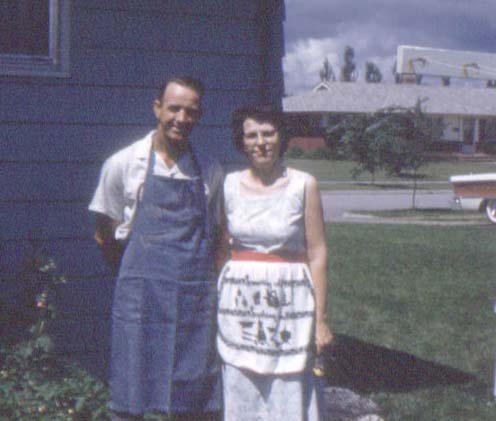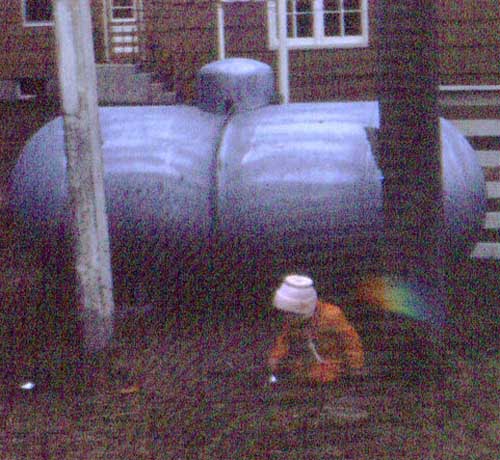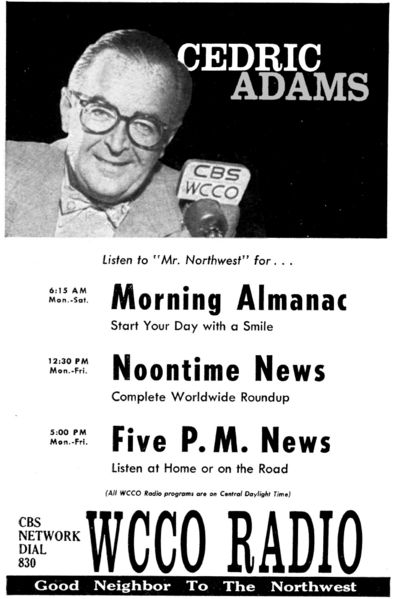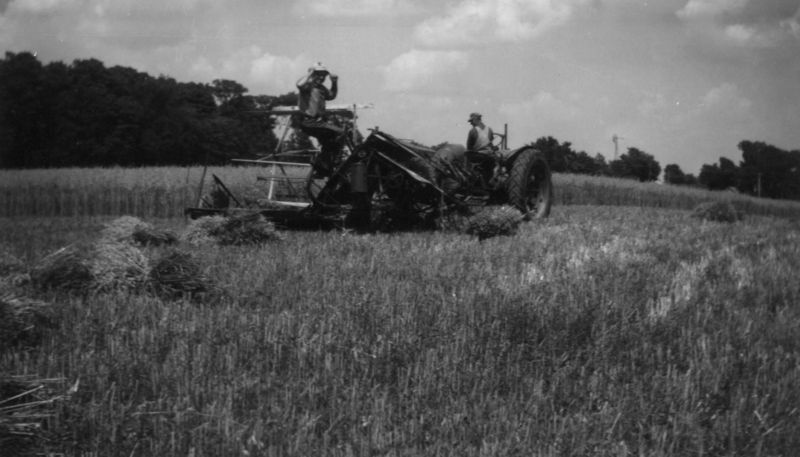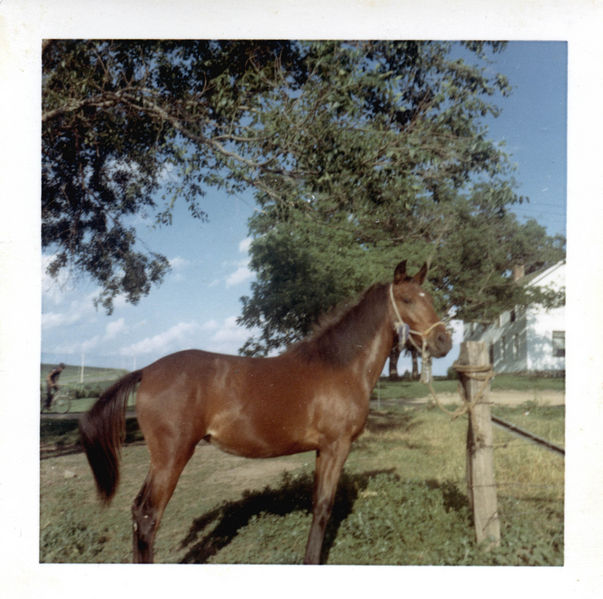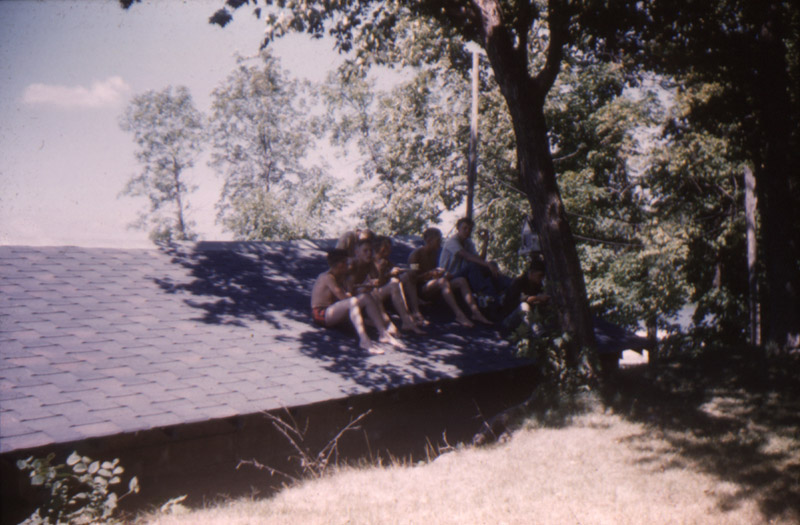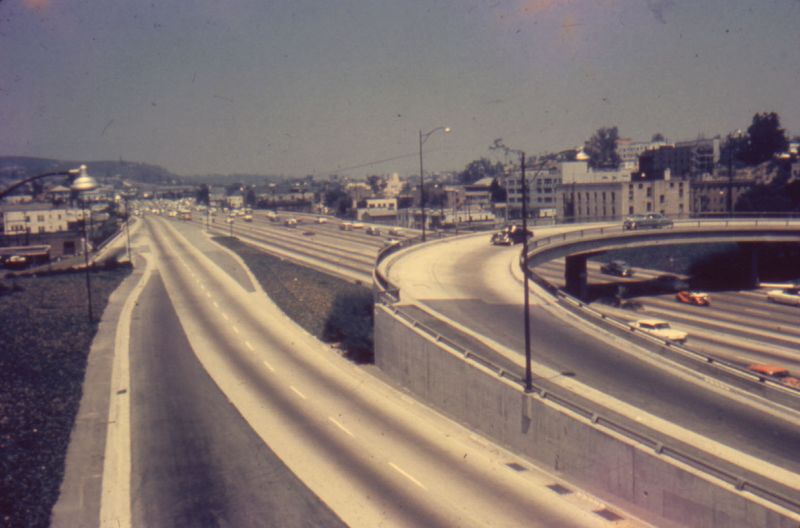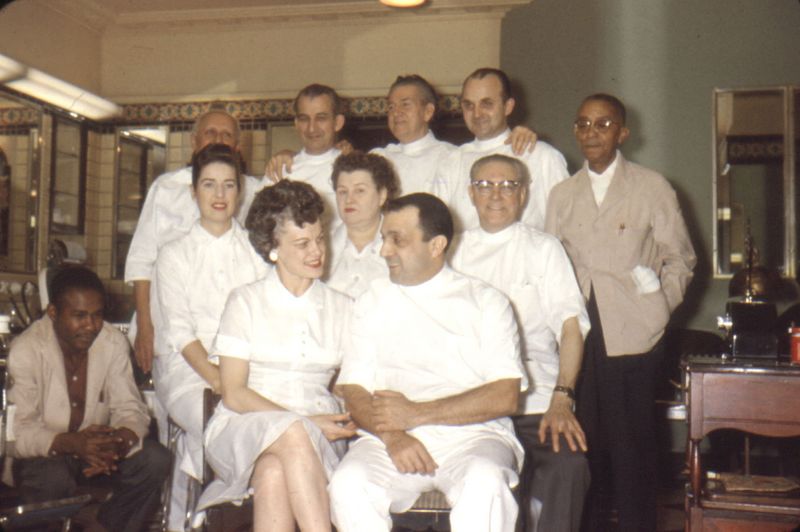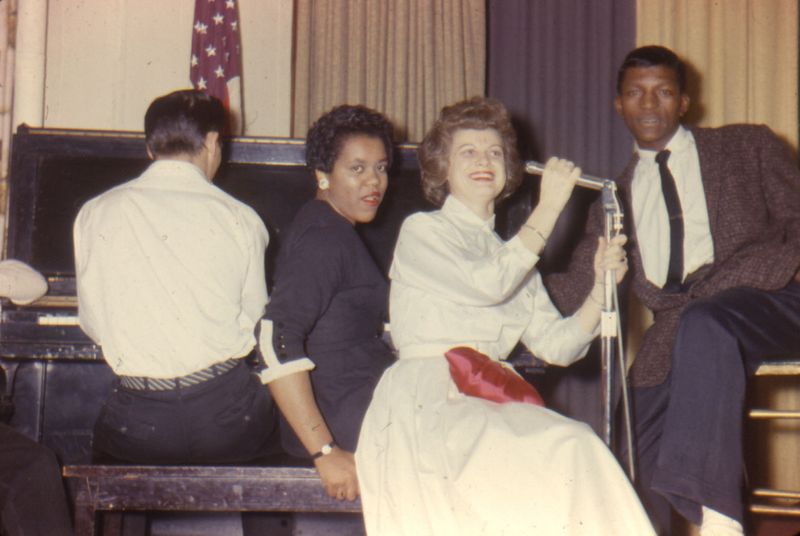 |

| |
|
|  |
Camera for the Year 2000, 1968.
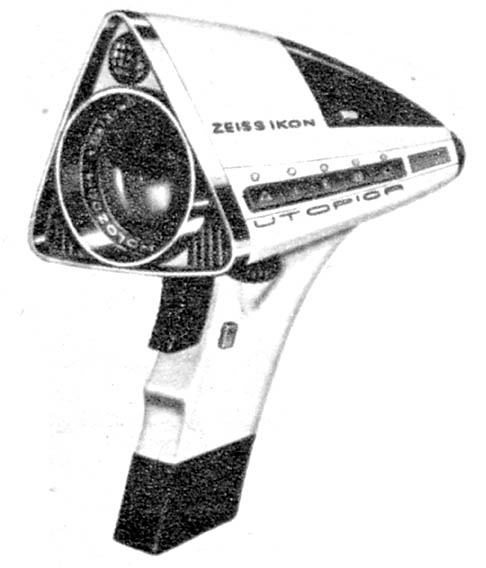
Click for more info In the late 1960s, Zeiss-Ikon designer Fritz Costabel was trying to wrap his brain around the Camera Of The Future. In an early 1968 issue of Photoguide Magazine, he described a machine capable of sending photos home wirelessly, radar auto-focusing, and push-button automation. A few months later, the camera above showed up in Mechanix Illustrated: the Zeiss-Ikon "Utopica". Looking a phaser sidearm off the Star Trek set, the camera was a multifunction machine: it could both instantly print photos like a Polaroid, but also make movies on 16mm film. The un-ergonomic shape and the focus on analog film were a bit short-sighted, but he was just about right on. Cameras today are automatic, double-duty as movie cameras, and can instantly produce a photo and allow it to be sent all over the world - and it certainly would have blown his mind to know that all of that photographic futurism is today considered an add-on to a portable telephone. Labels: 1960s, photography
Red River Flood, 1969.
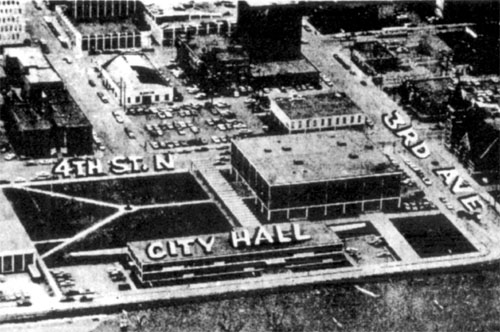
Click for full image In April, 1969, the Red River of the North overflowed its banks, reaching 37.3 feet on the 15th, and expected to crest at 38 feet a few days later. This aerial photo appeared on the front page of the Fargo Forum on the 15th, showing the dike's position in relation to saving city hall, the Civic Center, and the year-old library. Today, the dike runs down 2nd street, atop the river bank, but in 1969, they let the swollen river cover the big parking lot, and ran the dike along 3rd street, just outside City Hall's front doors; the Town House hotel, at the far right in the big picture, looks on the verge of flooding, but safe enough. Labels: 1960s, 1969, city hall, civic center, fargo, flood, library
Cold War Wind Patterns, 1963.
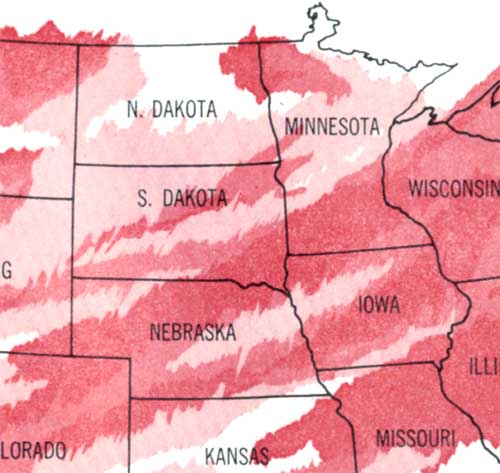
Click for full imageWhat does this map show? It relies on the wind patterns of an average spring day, in that particular decade. That decade was the 1960s, and about the biggest worry to be carried on those spring winds: fallout. This map projects fallout, if an "enemy" were to drop 3,000 megatons on various military, industrial, and civilian targets at the same time, both ground detonations and air bursts. From the Saturday Evening Post, 23 March 1963. Labels: 1960s, 1963, cold war, fallout shelter, maps, saturday evening post
Rural Civil Defense, 1960.
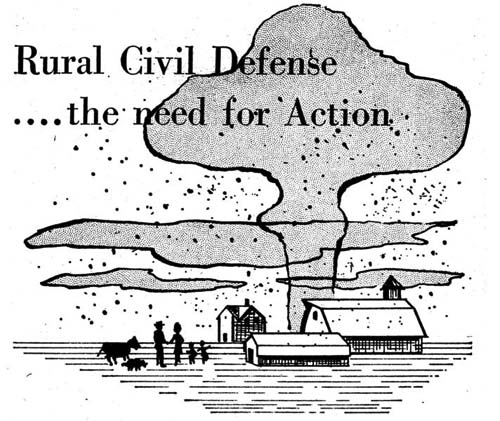 Bombs have fallen. At least one has struck St Paul-Minneapolis. Another has exploded above the Great Lakes port of Duluth-Superior. Air force [sic] bases at Grand Forks, Rapid City and maybe Minot have been hit. So have other areas...Here, there is nothing to do now but wait. Radioactive fallout, if it isn't already here, will be filtering down within the next hour or two. Heaviest concentration will be between the next 6 to 12 hours, with no one daring to leave the family fallout shelter. Tomorrow, it may be safe to run to the barn long enough to check on livestock. Not all animals could be gotten under cover, but the producing cows and most valuable breeding stock are inside. Cold War advice on preparing your farm for the inevitable nuclear war Bombs have fallen. At least one has struck St Paul-Minneapolis. Another has exploded above the Great Lakes port of Duluth-Superior. Air force [sic] bases at Grand Forks, Rapid City and maybe Minot have been hit. So have other areas...Here, there is nothing to do now but wait. Radioactive fallout, if it isn't already here, will be filtering down within the next hour or two. Heaviest concentration will be between the next 6 to 12 hours, with no one daring to leave the family fallout shelter. Tomorrow, it may be safe to run to the barn long enough to check on livestock. Not all animals could be gotten under cover, but the producing cows and most valuable breeding stock are inside. Cold War advice on preparing your farm for the inevitable nuclear war. From a 1960 issue of The Farmer. Labels: 1960, 1960s, cold war, nuclear war, the farmer
Merry Christmas, early 1960s.
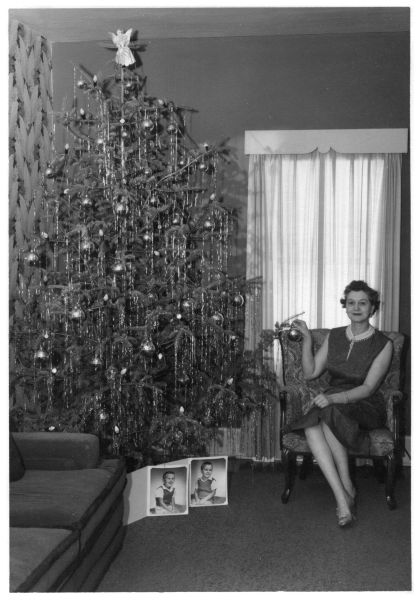 A woman holding a Christmas ornament, sitting next to two photos of children. Appears 1950s, or early 1960s. Labels: 1960s, christmas, christmas tree
Minnesota's Christmas Tree, 1961.
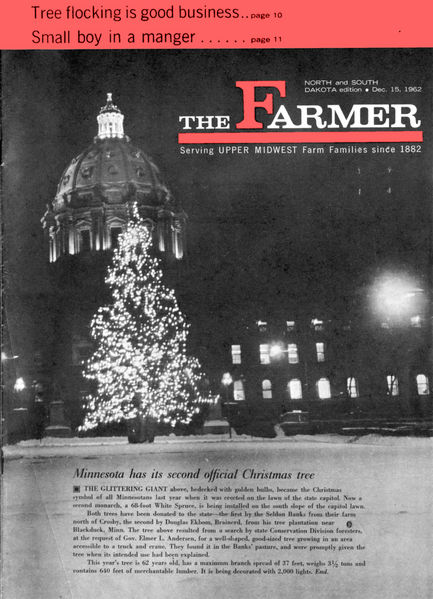 In 1961, new governor Elmer Andersen sent his finest tree-experts to find a grand tree, an amazing tree, a tree that was big and accessible to crane, to place on the State Capital lawn. The tree was found in the pasture of Seldon Banks, who donated it to the state. The image above is of Andersen's first official Minnesota Christmas Tree, from the year before; the misleading caption referring to the "Second tree" in the article is the 1962 tree that was erected before The Farmer could get a photo for their cover. Labels: 1960s, 1961, 1962, christmas, christmas tree, Elmer Andersen, minnesota history
John Deere 820, 1960s
 The John Deere 820 was, by some accounts, manufactured in the late 1950s, although some for sale say they were made in the 1970s. Known for its large-displacement 2-cylinder motor with excellent gear ratio, the 820 has been popular in tractor-pull events due to its inability to stall. This photo was the tail-end of a roll of slide film, and the film wasn't large enough to fit into a standard slide frame. The owner made due by tracing a slide frame onto cardboard, cutting it out, and taping the film into it. Labels: 1960s, 820, farming, john deere, tractor
Studebaker Municipal Vehicles, 1962.
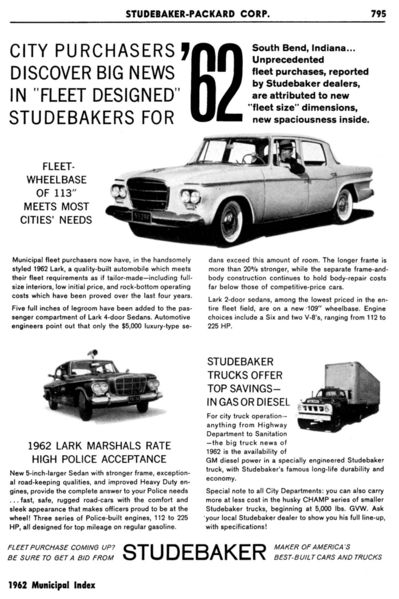 The 1962 Studebaker Lark had all sorts of features that a city would want in a fleet vehicle: the compact Lark was redesigned for 1962, with a 5" longer frame and a 109" wheelbase, and their "police-built" engines came in 112 and 225HP versions on 'regular' gasoline. Studebakers had been operating as police cars for several years before, but a larger, more robust machine was hoped to increase their scope. Sadly, just a couple years later, the Studebaker was gone in the U.S. after 1966. Labels: 1960s, 1962, automobilia, studebaker
Goldwater For President, 1964.
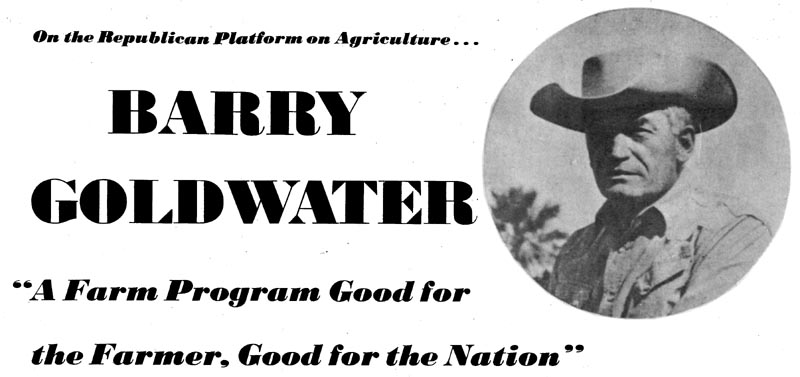 A Republican presidential candidate from Arizona can't lose, can he? Barry Goldwater stepped down from his seat in the Senate to run for president against LBJ...but was defeated in one of the worst landslides in history. He garnered only 52 electoral votes, compared to LBJ's four-hundred-eighty-six. Make sure you get out and vote today, and let's remind McCain what we think of Arizona Republicans. Labels: 1960s, 1964, barry goldwater, politics
Elmer For Governor, 1960.
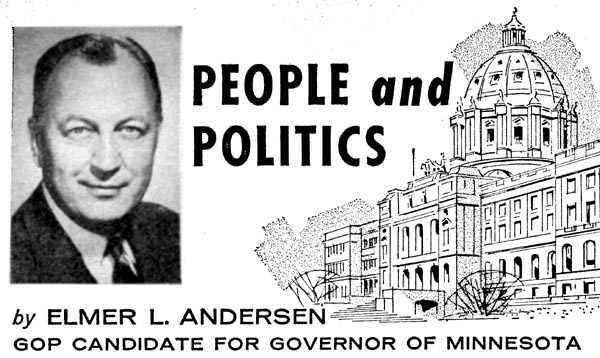 In 1960, Elmer was on the GOP ticket for Governor of the state of Minnesota. A few short weeks after he published this ad in The Farmer magazine, he won his bid, starting a controversy-free term in charge of the state. Two short years later, however, he was undone by 91 voters: in an extremely close election, he lost out to Farm-Labor candidate (and his Lieutenant Governor) Karl Rolvaag. Despite his Republican heart, Andersen was a self-proclaimed liberal to the end, even endorsing John Kerry during the 2004 election. Andersen passed away shortly thereafter. Labels: 1960, 1960s, Elmer Andersen, minnesota history, politics
Halloween Bowling, 1960.
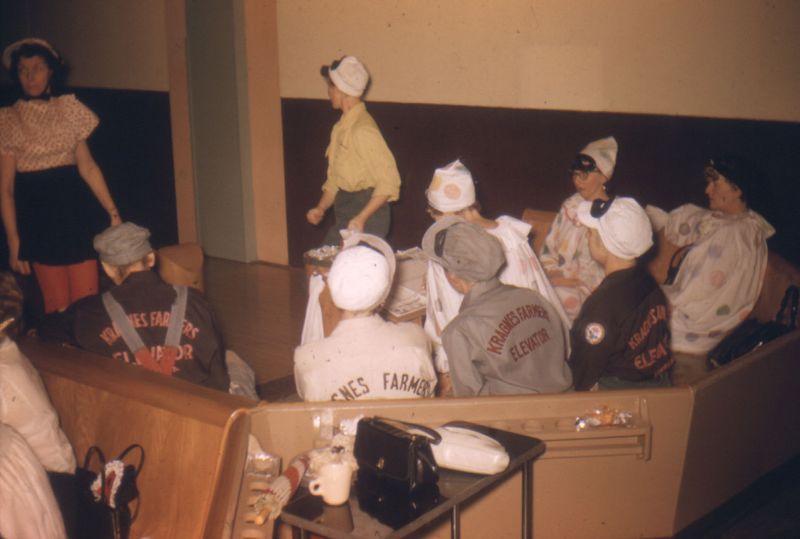 On the evening of October 31st, 1960, the gals from the bowling league got together and tossed the balls a few times. Being Halloween, they couldn't go without a costume, of course: some made due with just a black mask, but others got into it more. I see a couple clowns, a railroad engineer, and a Bo Peep. Labels: 1960, 1960s, bowling, costumes, halloween
"Reflectorize" Your Costumes, 1960.
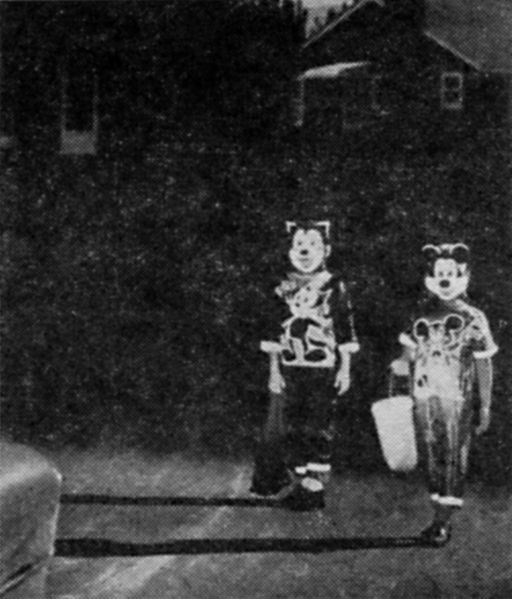 Felix the Cat and Mickey Mouse have been 'reflectorized', according to this article from 1960 on Halloween safety. You may think your parents were the first ever to be so lame as to worry about cars running over little Batmans and princesses on your neighborhood streets, but the worry has been around about as long as cars (but probably moreso about the time the suburbs began to flourish). My only thought about this picture is that it doesn't actually depict Halloween: in order to be included in the October 15th issue, the article and photo probably had to be in to the publisher by the 1st, and with photo developing time the picture was probably taken sometime in September. Imagine you're the two kids, dressed in your Halloween costumes a month early, walking around your neighborhood decked out in high-reflective tape, during the first couple weeks of school. Downright embarrassing. Labels: 1960, 1960s, costumes, halloween, safety
Malferd's Garden, 1960s.
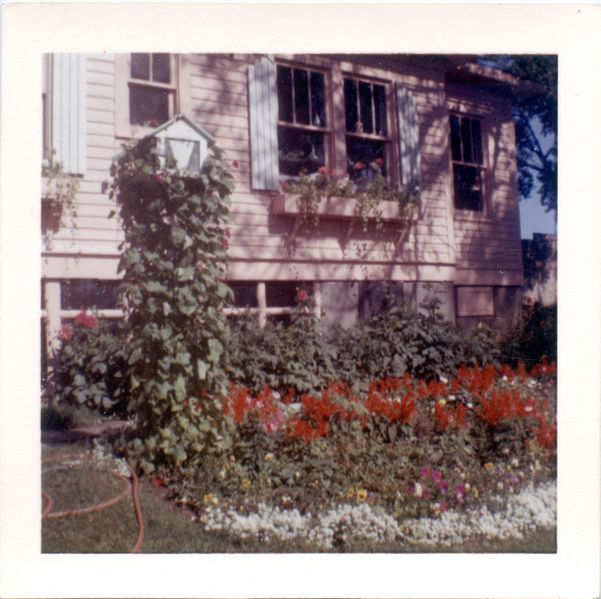 Note on back reads, " This is part of our house on the south side. Malferd & I both love to work in the yard." Color photo, appears 1960s. Labels: 1960s, flowers, garden
Horse, Fence, Bicyclist, 1960s
Family Photo, With Retriever, 1961
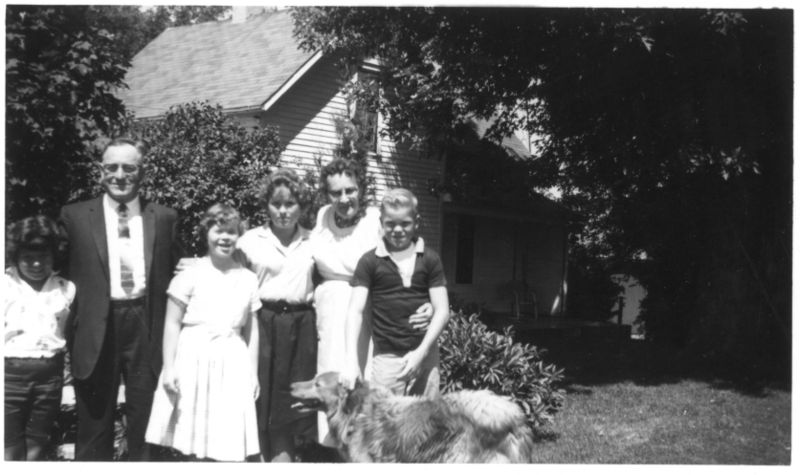 It's always hard to get the dog to look at the camera; more difficult, it seems, than to center the photo. Dated by photolab, August 1961. Labels: 1960s, dog, family photos
Never a More Wretched Hive of Scum and Villany
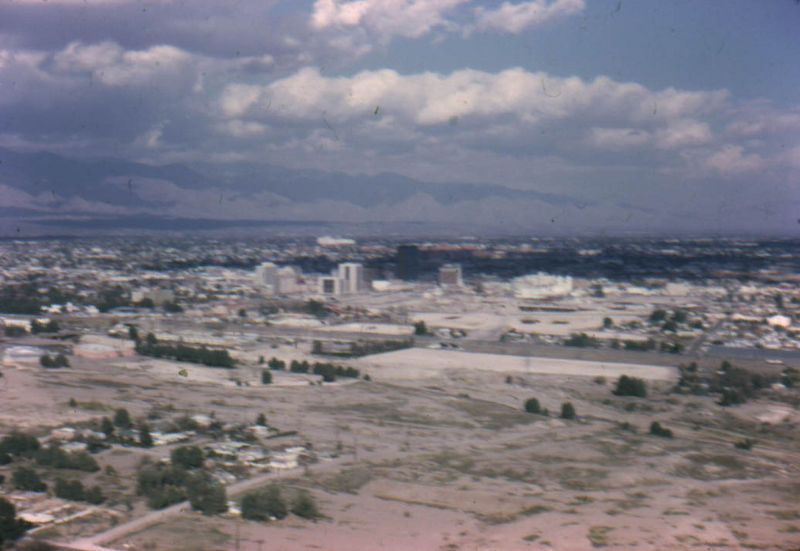 The perspective and content of this photo requires me to get a little geeky. When I first looked at it, I immediately connected it to a scene from Star Wars -- Luke and ObiWan are on their way to save the universe, and in procuring a ship they stop on a cliff overlooking the spaceport. ObiWan warns: " Mos Eisley spaceport. You will never find a more wretched hive of scum and villainy." The actual city, I don't know -- it appears to be in Arizona, given the content of other images in these slides, and the number of tall buildings would indicate it's not a tiny town. The odds of finding a Corellian starship for hire are probably low, though. Labels: 1960s, arizona, city, skyline
Space Flight - Ten Cents
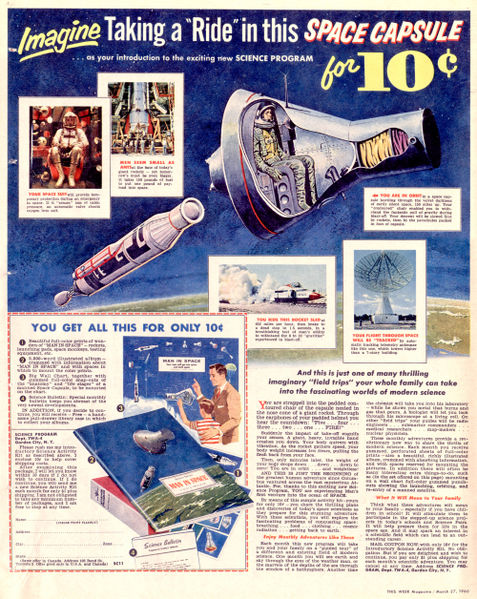 In 1960, you could drop a dime in the mail and get yourself some genuine space-flight experience! The Science Program was a subscription service, delivering a booklet devoted to a single subject each month. Ten cents was the introductory offer, but future booklets cost a dollar (plus shipping). Subscribers also got posters, star-charts, and other helpful activities to help teach about the varied topics, from nuclear power to cartography. Take a close look at the date, though: this advertisement was printed on the back of the 27 March 1960 edition of This Week magazine...a full year before the USSR and USA launched their respective manned spaceflights. The potential for wild speculation and amateurish writing was ripe, but the Science Service was above such things. Established in the 1920s, the Science Service was a newswire for scientific thought, sponsored and edited by scientists for accuracy and clarity to the layperson. These booklets were carefully written for accuracy, as much information as they had in the 1960s, and certainly inspired the minds of today's scientists and engineers. That is, if their parents could come up with a buck a month to keep the sticker books coming. Labels: 1960, 1960s, books, science program, science service, space flight
Lectra Haul Versus Ford Mustang
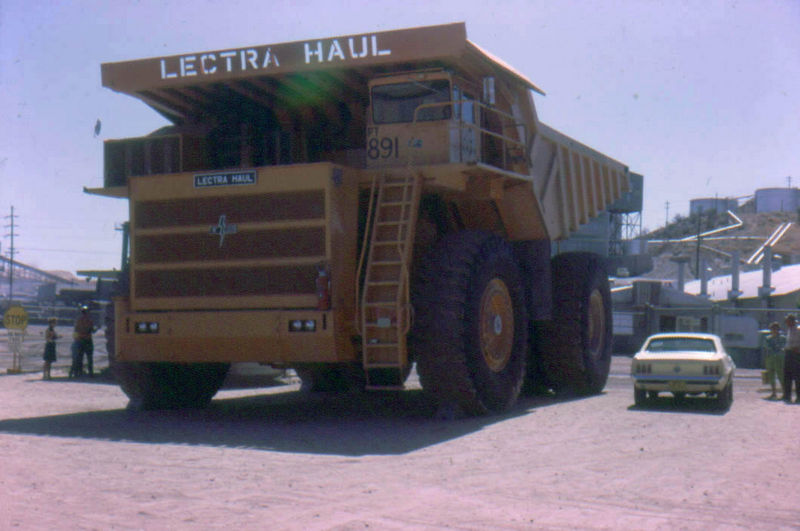 This undated photo, from the 1960s This undated photo, from the 1960s, shows just how big a Lectra Haul is. That, on the right, is a mid-1960s Ford Mustang. If the people standing next to the Mustang were to stand on its roof, they might just reach the top of the Lectra Haul's tire. This is actually a small one; although this was big in the early 1960s, as the decade progressed massive moving machines were growing in size at an alarming rate. This one could carry 85 tons, but by the end of the 1960s their manufacturer, Unit Rig, had moved on to bigger, more immense machines capable of carrying hundreds of tons at a time. Now, for this photo's origins -- this came from the same set of slides as the 4H parade, but the rest were all rather scattered about...no real order. So, I'm scanning them in no particular order. I do know it was taken in the 1960s, based on other slides with marked dates. A large number of the slides are taken in Arizona or California, although pictures of houses and interiors are quite clearly in Arizona. The background doesn't look like Arizona to me, though: distant oil storage facilities, overground pipelines, lots of 'nothin, it looks more like Oklahoma or Texas. Turns out, Arizona has an oil industry, so its likely that an oil company would have bought a Lectra Haul from Unit Rig (which also manufactured electrically-powered oil wells and equipment), and left it parked out where tourists could gawk at it. Labels: 1960s, arizona, lectral haul, unit rig
Forgotten Negro Books, Remembered Online
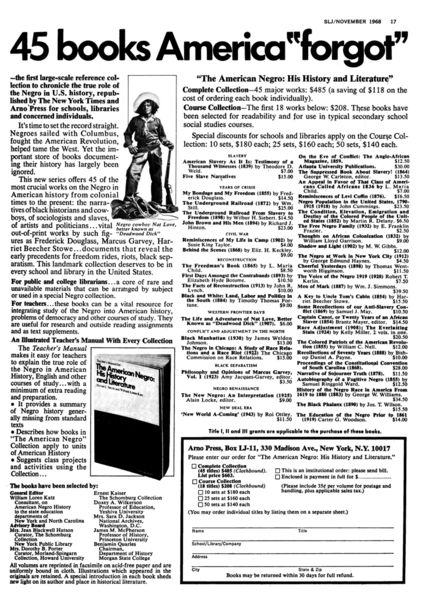 This advertisement This advertisement appeared in the November 1968 issue of School Library Journal; I'd wager that "forgot" is in shock quotes because they weren't truly forgotten (Sojourner Truth, Uncle Tom's Cabin, etc), but for the most part the books in this collection were somewhat obscure, given the subject matter and the educational system at the time. Negros were barely considered second-class citizens even in 1968 (just a couple years before I was born), so "forgot" can also apply to schools who neglected to include Negro history on their bookshelves among the Anglo-centric histories that are our libraries are still overly heavy with. This expansive collection would definitely prove to be an encompassing addition to a library, giving the probably Negro-lax knowledge of the librarians a break, removing their need to research and compile a list. Here it was, all lumped together, ready to be purchased as a $485 chunk. It'd probably look good on the budget request; to the probably overly-white adminstrative groups overseeing library acquisitions at the time, one $485 one-time purchase would look better than 45 individual purchases spread out over months as the books are discovered. Here's why Google Books, Project Gutenberg, Print-On-Demand, and other electronic publishing services are instrumental in modern education: The list of "forgotten" books are hardly forgotten today. Where, forty years ago, a library had to find nearly $500 -- probably a months' salary for one good librarian, or a half-dozen part-timer circulation desk workers -- nearly all of the books are available online today, most free to anyone with an internet connection...which, incidentally, is free in most libraries today. - American Slavery As It Is: Testimony of a Thousand Witnesses, by Theodore Weld (Google);
- My Bondage and My Freedom, Frederick Douglass (Google);
- The Underground Railroad, William Still (Arnold Bernhard Library);
- The Underground Railroad from Slavery to Freedom, Wilbur Siebert (Google);
- John Brown and His Men, Richard Hinton (Google)
- Reminiscences of My Life in Camp, Susie King Taylor (Google)
- Behind the Scenes, Elizabeth Keckley (Google)
- The Freedmen's Book, L Francis Child (Google)
- First Days Amongst the Contrabands, Elizabeth Hyde Botume (none at this time)
- The Facts of Reconstruction, John Roy Lynch (Google)
- Black and White: Land, Labor, and Politics in the South, Timothy Thomas Fortune (Google)
- The Life and Adventures of Nat Love Better Known as "Deadwood Dick" (UNC-Chapel Hill)
- Black Manhattan, James Weldon Johnson (Not Public Domain/in print)
- The Negro in Chicago: A Study of Race Relations and a Race Riot, Illinois Chicago Commission on Race Relations (Google)
- Philosophy and Opinions of Marcus Garvey, Amy Jacques Garvey ed. (not public domain/in print)
- The New Negro, Alain LeRoy Locke (not public domain/in print)
- 'New World A-Coming', Roi Ottley (not public domain/in print)
- On the Eve of Conflict: Anglo-African Magazine (not available)
- The Suppressed Book about Slavery!, George W. Carleton ed. (not available)
- An Appeal in Favor of that Class of Americans Called Africans, L. Maria Child (Google)
- Reminiscences of Levi Coffin (Google)
- Negro Population in the United States 1790-1915, John Cummings (not available)
- The Condition, Elevation, Emigration, and Destiny of the Colored People of the United States, Marin Delany (Gutenberg)
- The Free Negro Family, E. Franklin Frazier (not public domain)
- Thoughts on African Colonization, William Lloyd Garrison (Google)
- Shadow and Light, M W Gibbs (Google)
- The Negro at Work in New York City, George Edmund Haynes (Gutenberg)
- Cheerful Yesterdays, Thomas Wentworth Higginson (Google)
- The Voice of the Negro 1919, Robert T, Kerlin (Google)
- Men of Mark, Wm J. Simmons (Google)
- A Key To Uncle Tom's Cabin, Harriet Beecher Stowe (Google)
- Some Recollections of our Anti-slavery Conflict, Samuel J. May (Google)
- Captain Canot, Or, Twenty Years of an African Slaver, Brantz Mayer ed. (Google)
- Race Adjustment: The Everlasting Stain, Kelly Miller (not public domain/in print)
- The Colored Patriots of the American Revolution, William C. Nell (Google)
- Recollections of Seventy Years, Daniel A Payne (UNC-Chapel Hill)
- Proceedings of the Constitutional Convention of South Carolina (Google)
- Narrative of Sojourner Truth (University of Virginia)
- Autobiography of a Fugitive Negro, Samuel Ringgold Ward (UNC-Chapel Hill)
- History of the Negro Race in America from 1619 to 1880, George W Williams (Google)
- The Black Phalanx, Jos. T Wilson (Google)
- The Education of the Negro Prior to 1861, Carter G Woodson (Gutenberg)
Why did I mention Print-On-Demand? The 1968 editions advertised here from Arno Press, particularly the non-public-domain-editions, are still shown as available according to Amazon via Ayer Publishing with a 1-3 week wait. That sort of wait time, the type of business Ayer runs, and the existing 1968 publishing date means that this book, when ordered from Amazon, is printed in an instant on high-speed printers, bound and jacketed, and then shipped out in one constant motion. These modern technologies make available books that were once obscure and elusive. Once upon a time, you had to be a librarian with a big budget. Today, these books are available to anybody, in a comparative (or literal) instant, thanks to computers and publishing revolutions. Labels: 1960s, 1968, negro, print on demand, public domain, publishing
Iron Horse Tour of the Railroad Club of Chicago, 1964
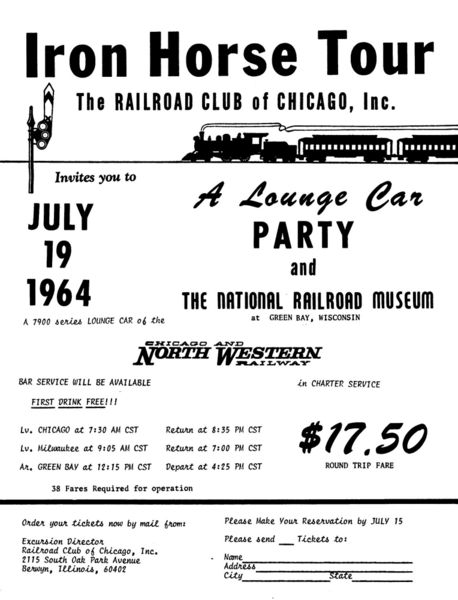 On July 19, 1964, a group of railroad aficionados piled aboard a 7900 series lounge car belonging to the Chicago and North Western Railway, en route to the National Railroad Museum in Green Bay, Wisconsin. The Railroad Club of Chicago sponsored this 'lounge car party,' bringing along friends from Milwaukee along the way, and providing one free drink in the fare. I imagine that a car-full of railroad guys -- at least 38 of them -- in a moving bar for five hours straight were a mighty friendly bunch when they disembarked in Green Bay. I'm pleased to see that the club is still around. Too often, 'archaic' clubs like these dwindle in numbers as their members age and fall away, but railroad people are an odd bunch; the romance of the rails meets men's natural affinity for huge, loud, mechanical machines, and you end up with some fun-loving guys who'll pile on a train and road-trip to Green Bay to see more trains. Today, they promote rail travel, discuss community history revolving around trains, and remind everyone that, even though trains are disappearing, they meant a lot to the United States we live in. Labels: 1960s, 1964, green bay, National Railroad Museum, railroad, Railroad Club of Chicago, wisconsin history
Fallout Protection for Homes With Basements
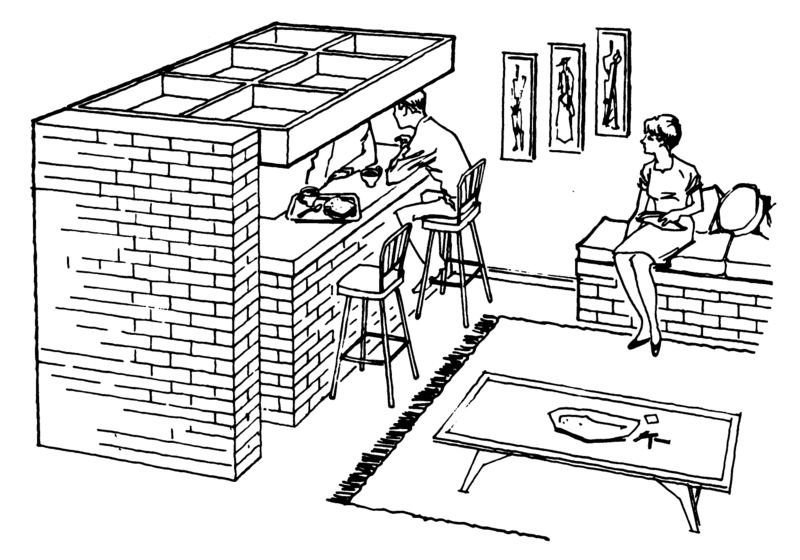 That swanky snack bar isn't a weekend project from Handy Andy -- it's secret is that the instant the Emergency Broadcast System begins to pierce the air, the snack bar converts into a fallout shelter. The booklet " Fallout Protection for Homes with Basements" -- available in online and hard-copy formats, was produced by Civil Defense and mailed out to homeowners who completed a questionnaire about their house's construction. Based on those answers, using an ' electronic computer', the CD calculated how much radiation protection your unshielded basement can provide...and offer a lot of advice on what to do if your basement comes up short. Unlike the traditional image of a fallout-shelter as an impenetrable fortress buried in the back yard, these fallout shelter suggestions are practical, cheap, simple...and aren't a waste of space if nuclear war never happens (knock on wood). What surprised me is the fact that fallout doesn't behave like a gas -- it falls like snow, piles up on the ground, but it's the radiation the fallout emits that is what will get you. The fallout shelters don't have doors, and the booklet says several times that if you must go do important things (read: use the toilet), you can wander about for a few minutes at a time. If you're hiding out under a converted snack bar, at least you won't have to go far for a can of peanuts. Labels: 1960s, 1967, civil defense, cold war, fallout shelter, nuclear war, retro style
Bertha
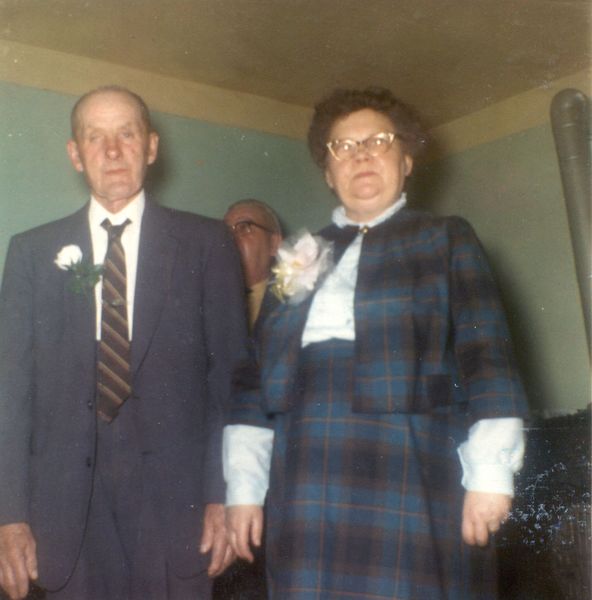 I've started scanning a new family photo album -- another one from Wisconsin, and this one had all the 'good' photos removed, leaving the ones I'm scanning behind. Why were they rejected? I can't tell. Most of these photos are also unmarked -- but the one to the right was important enough to be captioned: " Bertha and Husband." I wonder which one's Bertha? Labels: 1960s, boutinniere, older couple, plaid dress
Arrangement in Gray and Black: Melby's Mother
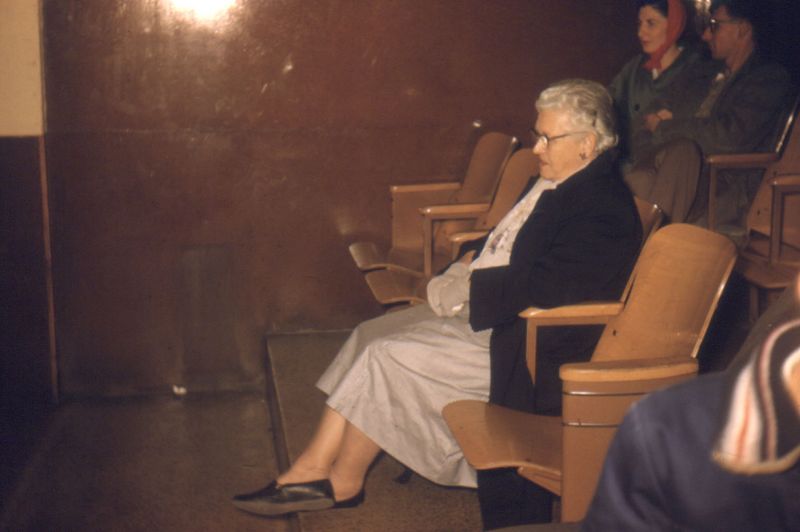 Whistler's Mother Whistler's Mother (otherwise known as Arrangement in Gray and Black No. 1) is an iconic image in our culture, recalling a Victorian silence and respectability. Mrs. Melby's Mother, above, spent Halloween 1960 at a bowling alley. My, how times change is a little less than a century! Not quite as much as you may think, though -- the style of dress is similarly modest, although Mrs. Melby has gone stocking-free and is showing a little ankle. Her chair is similarly spartan, although anyone who attended a high school built earlier than 1960 is probably intimately familiar with such folding seats; many a small finger has been bit by those steel hinges while screwing around during an oh-so-important school assembly in the auditorium. Labels: 1960, 1960s, bowling, minnesota, vintage photo
Pfister Hotel Barber Shop Staff, 1960
4H IH Scout
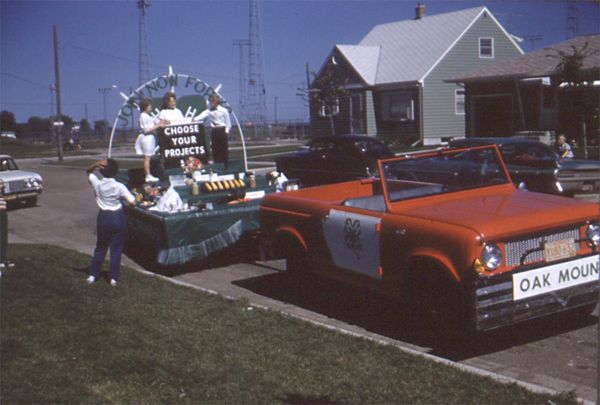 The float aside, that bright red truck is the focus here (also seen here, and here) The owner of this truck was a forward thinker: the shiny, new truck seen here was from the first year International Harvester made the Scout, its answer to the Jeep. At the time, tractor manufacturers weren't specifically tractor manufacturers: they made all kinds of motorized stuff beneficial to farmers. IH saw a need for a heavy-duty farm vehicle that Willis' Jeep was fulfilling, and came up with the Scout. Ford eventually followed with its Bronco, but the gas-conservation of the 70s mostly killed off these smaller versions of what we'd call an SUV. You may not know, but IH made the Scout until 1980: that's almost 20 years on the road. Labels: 1960s, 1961, 4h, automobilia, ih, international harvester, scout
Scenic California
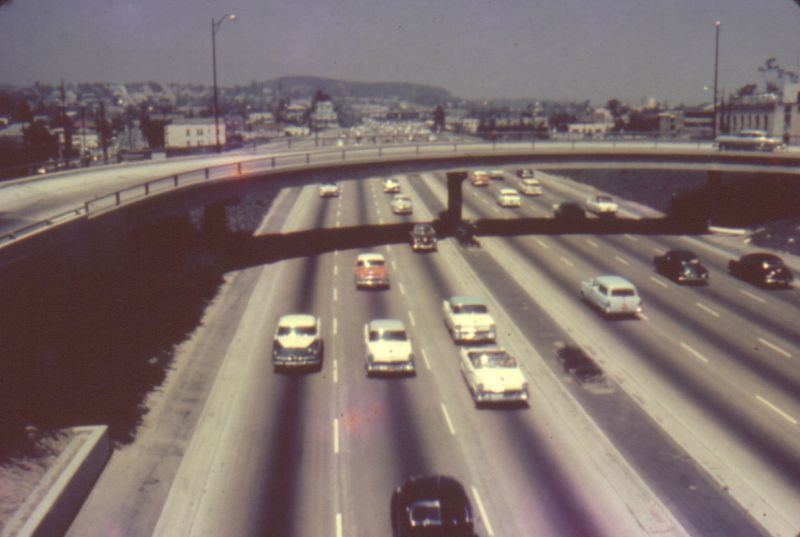 I know I've been picking on North Dakota for its scenic vastness, but is this so much better? Back in the 1960s, California was so proud of its freeway system that -- like Arizona with its Grand Canyon, South Dakota with its Mount Rushmore, New York with its Niagara Falls -- they released a set of collectible slides documenting the Los Angeles Freeway System. MARVEL at the expanses of concrete and pavement! SMELL the pollution wafting up from the vehicles! CRINGE IN TERROR at how close those two cars are in the third lane from the left! Oh, I kid -- unlike where I live, you can actually see some hills off towards the horizon. Between here and there, however, is a concrete jungle. I still prefer here. see also: pre-freeway map * California highways * more photos * just newer cars today * house stranded on CA highwayLabels: 1960s, california history, freeway, highway, vintage photo
Party at the Pfister, 1960
4H in Downtown Moorhead, Minnesota, 1961
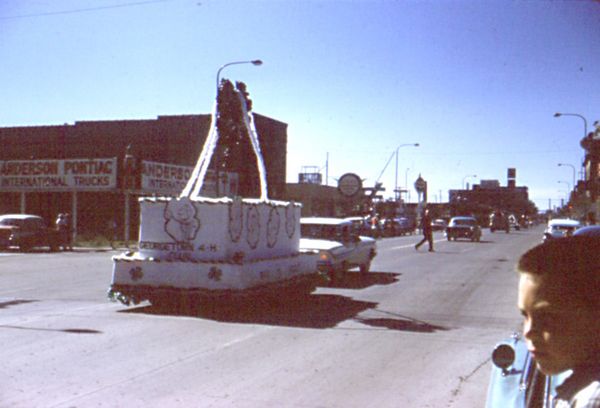 This photo was taken This photo was taken, looking west, down Center Avenue in Moorhead Minnesota, in 1961. These floats, all from 4Hers around Clay County, were on their way to the 4H Roundup in town. Much of what's seen here is still around, despite the flurry of Urban Renewal a few years later (most of that happened just off to the right of the photo) -- in the distance, that tall sign is the FM Hotel, now an office building; the sign now has the US Bank logo. That building in the foreground, with the Anderson Pontiac sign, and the building next to it, are still around, but I'm not sure what's occupying them now. see also: older Washington 4H parades * Cali 4H in the 20s * Moorhead Center Mall historyLabels: 1960s, 1961, 4h, minnesota, minnesota history, moorhead, parade
|  |
|
|












